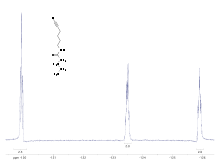Fluorine-19 NMR

Fluorine-19 nuclear magnetic resonance is an analytical technique used to identify fluorine-containing compounds. 19F is one of the most important nuclei for NMR spectroscopy.[1]
Operational details
19F has a nuclear spin of 1/2 and a high magnetogyric ratio, which means that this isotope is highly responsive to NMR measurements. Furthermore, 19F comprises 100% of naturally-occurring fluorine. Other NMR-active nuclei spin 1/2 that are monoisotopic (or nearly so) are 1H and 31P.
Because of its favorable nuclear properties and high abundance, 19F NMR measurements are very fast, comparable with 1H NMR spectroscopy. Indeed the 19F nucleus is the second most receptive NMR nucleus, after the 1H nucleus.
The reference compound for 19F is CFCl3, [2] although in the past a number of other compounds have been used, including CF3COOH (-76 ppm w.r.t. CFCl3) and C6F6 (-163 ppm w.r.t CFCl3)
Applications
Most commonly 19F NMR spectroscopy is mainly used to analyze the structure of organofluorine compounds. Representative targets of this method are the many pharmaceuticals that contain C-F bonds. The technique is also used to analyze fluoride salts.[3]
References
- ↑ H. Friebolin "Basic One- and Two-Dimensional NMR Spectroscopy", Wiley-VCH, Weinheim, 2011. ISBN 978-3-527-32782-9
- ↑ Roy Hoffman (2007). "19Fluorine NMR". Hebrew University.
- ↑ Gerken, M.; Boatz, J. A.; Kornath, A.; Haiges, R.; Schneider, S.; Schroer, T.; Christe, K. O. "The 19F NMR shifts are not a measure for the nakedness of the fluoride anion" Journal of Fluorine Chemistry (2002), 116(1), 49-58. doi:10.1016/S0022-1139(02)00101-X
| ||||||||